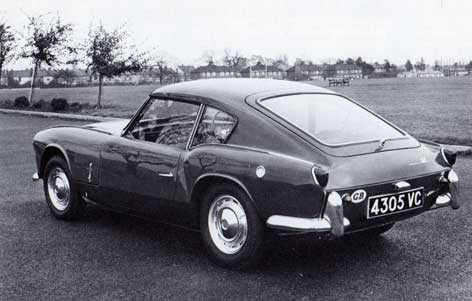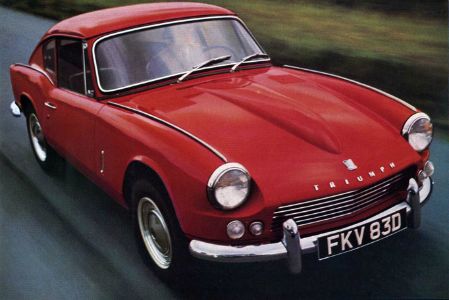
History of the GT6
Ironically the GT6 may not have existed without Donald Healey, the pre-war technical director of Triumph who designed the Triumphs’ Southern Cross, Dolomite and Gloria. Unfortunately the original Triumph car company went bust just before the war started. In 1945 Sir John Black’s Standard Motor Company bought Triumph, but as the factory had been destroyed, in effect they only had the rights to the name which was used for a series of sports cars. Post war Donald Healey himself started his own sports car company, eventually teaming up with Austin.
Americans fell in love with British sports cars, embodied by the MG T series Midget which their soldiers had experienced while “over here”. After the war MG started exporting their sports cars, and they were quickly followed by Jaguar and Austin-Healey, all of whom helped to earn badly needed dollars.
Of these, Donald Healeys Austin-Healey company, came up with the idea of a simple small sports car which would be the successor to the sporting versions of the pre-war Austin Seven. The resulting Austin-Healey Sprite which he designed, sold so well that Triumph, already makers of the TR series, decided to emulate it with their own small sports car (code named 'Zobo') based on a the shortened chassis of the Triumph Herald. According to Steven Parissien in his book A New History of the Motor Car, Michelotti had, unbidden, designed what was to become the Spitfire based on the existing Triumph Herald. Alick Dick, then Triumphs boss, said that "Michelotti was always reeling off new designs; you just couldn't stop him!", so perhaps the original idea was originated by a combination of Giovanni Michelotti and Alick Dick. According to Graham Robson*, "the Sprite was launched in mid-1958, a year after the original ' Zobo sports car' had been discussed. Although Standard-Triumph and BMC had been direct rivals for some time, the Spitfire was not a knee-jerk reaction to the Sprite. The appearance of the Sprite, however, was a great spur to Harry Webster's ambitions. Before the arrival of the Sprite, he thought his team could do a better job, after the launch he was convinced of this!"
The engine, gearbox and front suspension were based on the Standard Eight/Ten introduced in 1953 (cars, known within the Standard Triumph organization at the time as the “small car” or SC), see period brochure cover below:

They had new 803cc (Eight) and 948cc (Ten) engines designed by David Eley. He eventually designed the 6 cylinder versions which powered the 2000, 2500, 2.5 PI, TR5/6, Vitesse and GT6.
The original remit for the Standard 8/10 replacement was for a car that could be easily assembled in commonwealth countries such as India, Australia and South Africa and in various styles i.e. saloon, estate or convertible. The use of a separate chassis on which to easily build these styles was proposed by Harry Webster (Triumph’s Director of Engineering). The use of chassis rather than the more modern monocoques was a bold move in the late 1950s but was also a solution to Standard Triumph’s lack of body making facilities, previous supplier Fisher & Ludlow had been purchased by BMC! It did facilitate the later development of the sports cars: Spitfire and GT6, using a modified chassis.
All these cars were designed by Giovanni Michelotti who was employed by Standard Triumph’s Harry Webster through a happy accident! In 1957 a Captain Raymond Flowers who ran the Cairo Motor Company in Egypt was looking for a small and economical engine for a car which would ultimately become the Frisky, and he contacted Harry Webster, expressing an interest in the engines manufactured for the Standard 8 and 10. During their meeting Captain Flowers let slip that he had an Italian designer who worked for Vignale who could produce a prototype in 3 months. This led to Standard Triumph using Vignale (through Captain Flowers) to redesign the TR3 into the ‘TR Dream Car’, see below. This was shown at the 1957 Geneva Motor Show.

Triumph eventually discovered that the Vignale designer was in fact Giovanni Michelotti, and this led to him being hired to eventually design the Herald/Vitesse, and later the Spitfire/GT6.
The sports cars came about due to then MD Alick Dick who, it is claimed, wanted to see a sports version of the Herald to possibly compete with current MGs and Austin-Healeys after seeing Michelottis off-the-cuff drawings. The 1958 Austin-Healey Sprite was based on the mechanicals of the Austin A35, similarly the new Triumph sports car was to be based on Triumph Herald mechanicals. Michelotti, who was ‘always reeling off new designs’ penned the Spitfire for Triumph, based on a modified Herald Chassis.
Construction of a prototype code named 'Bomb' was started in September 1960 in Michelotti’s Turin studio. It was designed to be better than the more basic Sprite; it had wind-down windows instead of side screens and a proper boot! This prototype lay forgotten under a dust sheet in the design department of the factory, as there were no funds to bring it to production. However in April 1961, after the Leyland takeover, the newly installed MD Stanley Markland was taken on a tour of the factory by Harry Webster. According to Graham Robson, Stanley Markland looked at it, sat in it, walked around it and then turned to Harry Webster and said “That’s good, we’ll make that”. This Triumph Spitfire 4, retrospectively known as the Mk1 was launched at the 1962 Earls Court Motor Show.

As the original Austin-Healey Sprite influenced the decision to make the Spitfire, it is possible that the MGB GT, introduced in October 1965, influenced the decision to make the GT6. MG had considered a GT version of the MGB prior to the introduction of the original roadster version in May 1962. Harry Webster initially asked Mitchelotti to design a GT version of the Spitfire in 1963 and later that year the bright red prototype, registered 4305VC, was driven by Triumph test driver Fred Nicklin from Turin to Coventry, "When I stopped overnight in France, a crowd gathered round to admire the car - it was beautiful and they had never seen anything like it". However the additional weight of the “tintop” made it underpowered with the 1147cc engine, even though the aerodynamics had improved (a similar problem occurred with the MGB GT). This car is shown below.

In 1964 the Competition Department borrowed the original Spitfire GT to make fibreglass roofs for the Le Man Spitfire to improve its aerodynamic efficiency! Hence the term “Born in Le Mans” used by Triumph to promote the new GT6, which was in fact technically incorrect, as the GT came first! The obvious solution to the power problem was to shoehorn in the six cylinder engine from the Vitesse, and by the time of its introduction in 1966 both the Vitesse and the new GT6 had the larger capacity 2 litre versions of this engine. This lead to the name Triumph GT6. According to John Thomason “Triumph had managed to create a new car with a totally different character to that of the Spitfire”.


According to the CAR magazine 1966 Show Special "Triumph's new GT6 has a character all its own", the cover photo is below, complete with glamorous lady!

GT6 Mk1

The original GT6 of 1966 (retrospectively known as the Mk1) was made between July 1966 – Sept 1968, selling nearly 16,000, mainly to America. This had a 1998cc 6 cylinder engine which produced 95bhp. The suspension of the Spitfire was retained although bigger front disc brakes and calipers were fitted. The interior was much better appointed than the Spitfire with more comfortable bucket seats, proper carpets, more padding and a more comprehensive wood veneer dashboard. The motoring press did find fault, however, with the handling and lack of ventilation. The swing axle rear suspension, which could 'tuck under' with hard cornering could lead to loss of control. Standard-Triumph took these criticisms on board with the introduction of the Mk2, introduced in July 1968.
GT6 Mk2 (GT6+ in the USA)

The Mk2 came out in July 1968 and answered many criticisms of the original GT6 in the motoring press. The swing axle rear suspension, which could 'tuck under' with hard cornering leading to loss of control, was modified. This was done quite cleverly as a bottom wishbone was introduced, with the rear transverse spring acting as a top wishbone. The movement of the driveshaft necessitated the introduction of Dunlop's Metalastik "Rotoflex" driveshaft couplings which had already been used in the Triumph 1300 saloon. The roadholding was transformed! The engine benefited from the new better breathing TR5 cylinder head, this increased power to 105bhp. Ventilation was introduced with eyeball vents and a grill on the rear quarter; bumpers were raised to comply with American regulations; the interior was also updated with matt black instrument surrounds and a matt finish to the wood veneer. In October 1969 the model was further updated with a strengthened body, reclining seats, and a new combined reversing light/number plate light (common to the similarly modified Spitfire Mk3).
GT6 Mk3

The Mk3 was introduced in October 1970 to improve flagging sales. The style was 'updated' by Mitchelotti on similar lines to the Triumph Stag (as was the Spitfire MkIV) with a similar cut-off tail. The tailgate was the same as was the floor and central section of the body, only the previously removable windscreen frame (which the GT6 shared with the earlier Spitires and TRs) was replaced with a slightly higher one which became part of the front pressing. The bonnet was also new. The mechanics were unchanged from the earlier Mk2, as was the interior. Later updates included brushed nylon seats, headrests, sundym glass and a Girling brake servo.
Production Figures
Below are some alleged production figures (40,926 in total from 1966 to 1973, only 8 years) by mark. Please note the discrepancy between the ranges of chassis numbers and the 'production' figures! For example the Mk1 production figures are 15.818 but the range of chassis numbers is only 13,572! It is not known how many of the later versions of the Mk2 (from KC75031) were produced, but I suspect it may be less than 50% of the 12,066 total as these seem to be rarer.
| Model | Chassis No. | No. made |
| Mk1 (July 1966-Sep. 1968) | KC1 - KC13572 | 15,818 |
| Mk2 (July 1968-Oct. 1969) | KC50001 - KC58046 | 12,066 |
| Mk2 (October 1969-Dec. 1970) | KC75031 - KC83397 | |
| Mk3 (October 1970-Dec. 1973) | KE0001 - KE24218 | 13,042 |
Below are production figures by year. 1968 will include Mk1 and Mk2, and 1970 will include Mk2 and Mk3! Total Export & CKD (Completely Knocked Down) are four times those sold in the home market.
| Year | Home | Export & CKD | Total |
| 1966 | 68 | 1,366 | 1,434 |
| 1967 | 1,824 | 5,542 | 7,366 |
| 1968 | 771 | 6,247 | 7,018 |
| 1969 | 713 | 6,277 | 6,990 |
| 1970 | 622 | 4,781 | 5,403 |
| 1971 | 1,190 | 4,412 | 5,602 |
| 1972 | 1,745 | 2,950 | 4,695 |
| 1973 | 1,679 | 1,066 | 2,745 |
| Total | 8,612 | 32,641 | 41,253 |
| Source: Graham Robson * | |||
To see more details of Production dates, commission nrs. & changing points click here.
* In his book 'Triumph Spitfire and GT6 - A Collector's Guide' (Motor Racing Publications 1991).
![]()